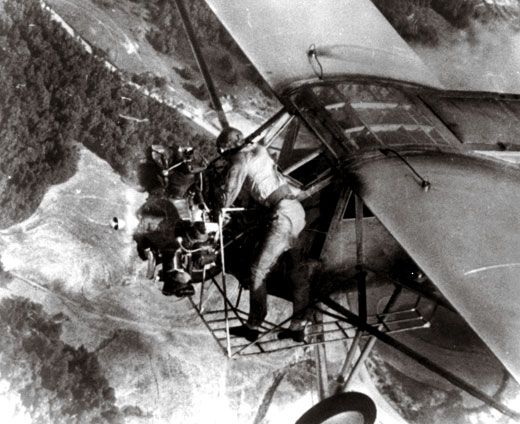The Pressure’s On
The ingenious—and goofy—modifications of endurance flights.
/https://tf-cmsv2-smithsonianmag-media.s3.amazonaws.com/filer/Moments_and_Milestones_Pressure_1_FLASH.jpg)
Aircraft piston engines rely on a continuous flow of lubricating oil to prevent wear, so one of the key instruments pilots monitor is the oil pressure gauge. If the oil pressure drops below a minimal level, the engine won’t run much longer. Although all aircraft engines consume oil, they use it up very slowly, and a pilot can be confident that the average flight will end with plenty of oil left in the engine.
Oil consumption becomes a real concern, though, during endurance flights, and the need to ensure a steady supply of engine oil has led to some ingenious, if occasionally goofy, modifications.
In 1935, the throes of the Depression, two brothers who managed the airport at Meridian, Mississippi, were down on their luck. So Fred and Al Key came up with a plan to set a new endurance record by flying continuously in a circle over Meridian and refueling from another aircraft that would uplift fuel from the ground and drop a hose to them. To keep gasoline from spilling during the transfer—a serious fire hazard—they teamed up with a local inventor to devise a nozzle that would close automatically if it accidentally detached.
They also built a kind of scaffold on both sides of the engine so that Fred could clamber out of the cabin and perform maintenance, including servicing the crankcase with oil. After the catwalk was installed, the Curtiss Robin looked like it had collided with a jungle gym, but the idea worked.
By the end, the Key brothers had consumed some 6,000 gallons of gasoline and 300 gallons of oil in a flight that lasted from June 4 to July 1—27 days, five hours, and 34 minutes. The two men rendezvoused with their support aircraft more than 400 times, obtaining food, supplies, and, of course, fuel. By the time they landed, tens of thousands had gathered at the little airport, and Meridian was on the map.
Almost 25 years later, Robert Timm, an employee of the Hacienda hotel in Las Vegas, got an idea: He and a copilot would break the Key brothers’ endurance record in a Cessna 172 and publicize the hotel’s name in big letters on the airplane. The hotel owner went for it and financed the effort.
Timm modified the 172 by rerouting the oil lines and oil filter through the airplane’s firewall—the metal barrier that separates the engine from the cabin—so the oil could be replenished and changed from inside the cabin. Timm and John Cook, an experienced pilot, took off from Las Vegas’ McCarran Airport on December 14, 1958, and flew continuously until they landed on February 7, 1959—64 days, 22 hours, 19 minutes, and five seconds.
Timm and Cook added a belly tank to the Cessna and pumped fuel from a truck speeding down a long stretch of straight road. They’d drop a grappling hook, snag the fuel hose, then pull it up; it took about three minutes.
Even the round-the-world flight of the Voyager in December 1986 required some thoughtful engineering. Oil was pumped to the engine with a hand crank on the rear bulkhead above the oxygen. According to their book Voyager, Dick Rutan and Jeana Yeager had to check the oil every four to six hours, and if it needed filling, it was Jeana’s job to lie on her back and reach over her right shoulder to turn the crank. “It took four hundred cranks per quart to get the oil into the system, and in that awkward position it was tiring work,” she wrote.
